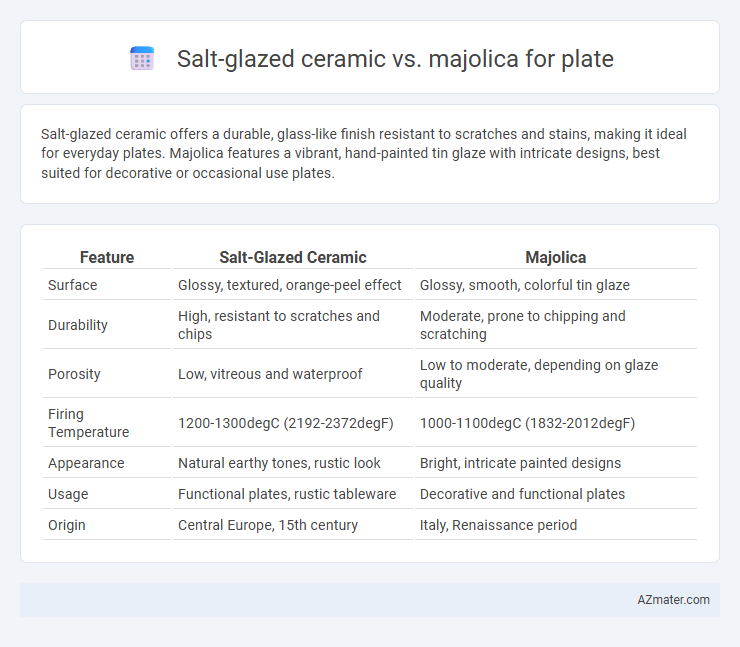Salt-glazed ceramic offers a durable, glass-like finish resistant to scratches and stains, making it ideal for everyday plates. Majolica features a vibrant, hand-painted tin glaze with intricate designs, best suited for decorative or occasional use plates.
Table of Comparison
| Feature | Salt-Glazed Ceramic | Majolica |
|---|---|---|
| Surface | Glossy, textured, orange-peel effect | Glossy, smooth, colorful tin glaze |
| Durability | High, resistant to scratches and chips | Moderate, prone to chipping and scratching |
| Porosity | Low, vitreous and waterproof | Low to moderate, depending on glaze quality |
| Firing Temperature | 1200-1300degC (2192-2372degF) | 1000-1100degC (1832-2012degF) |
| Appearance | Natural earthy tones, rustic look | Bright, intricate painted designs |
| Usage | Functional plates, rustic tableware | Decorative and functional plates |
| Origin | Central Europe, 15th century | Italy, Renaissance period |
Introduction to Salt-Glazed Ceramic and Majolica Plates
Salt-glazed ceramic plates feature a distinctive glossy finish created by throwing salt into the kiln at high temperatures, resulting in a durable, glass-like surface resistant to liquids and stains. Majolica plates are characterized by their vibrant, colorful tin-glazed surfaces with intricate hand-painted designs, originating from Renaissance Italy and known for their decorative appeal. While salt-glazed ceramics emphasize functionality and rustic elegance, majolica plates highlight artistic expression and ornamental detailing.
Historical Origins and Development
Salt-glazed ceramics originated in 15th-century Germany, characterized by a glossy, textured surface achieved by throwing salt into a kiln during firing, while Majolica traces back to the Renaissance period in Italy, featuring tin-glazed earthenware decorated with vibrant, colorful patterns. Salt glaze developed primarily for utilitarian stoneware with an emphasis on durability and simplicity, whereas Majolica evolved as decorative pottery emphasizing intricate designs and artistic expression. Both techniques significantly influenced European ceramic traditions, with salt glaze rooted in functional innovation and Majolica celebrated for its ornamental heritage.
Materials and Production Techniques
Salt-glazed ceramic plates are created by throwing salt into a hot kiln, causing the sodium to react with the silica in the clay and form a distinctive, durable glassy surface. Majolica plates use a tin oxide glaze that produces an opaque white surface, which is then hand-painted with vibrant metal oxide colors before firing. The key differences lie in salt glazing's chemical vapor technique producing a textured, glossy finish versus Majolica's tin-glaze method allowing intricate, colorful designs.
Surface Texture and Aesthetic Appeal
Salt-glazed ceramic plates exhibit a distinctive, slightly glossy surface texture with a subtle orange-peel effect created by vaporized salt reacting with the clay body during firing. Majolica plates feature a vibrant, glossy, and smooth surface, achieved through a tin-glazed coating that allows for intricate, colorful designs and detailed artistry. Salt-glazed ceramics offer a rustic, earthy aesthetic, while Majolica provides a bright, decorative appeal ideal for ornamental use.
Color Palette and Decorative Styles
Salt-glazed ceramics feature a natural, earthy color palette dominated by muted browns, greys, and blues, achieved through high-temperature firing that creates a unique, glossy surface with subtle textural variations. Majolica plates boast a vibrant, colorful palette with bright blues, greens, yellows, and reds, enhanced by tin-glazed earthenware that allows detailed, hand-painted decorative patterns and intricate motifs inspired by Renaissance and Mediterranean designs. The decorative style of salt-glazed ceramics leans toward rustic and understated elegance, while majolica emphasizes bold, ornate, and vividly expressive artistry.
Durability and Functional Performance
Salt-glazed ceramic offers superior durability due to its dense, vitrified surface that resists chipping, scratching, and thermal shock, making it ideal for everyday plate use. Majolica, while visually striking with its colorful tin-glazed finish, tends to be more porous and prone to crazing, which can compromise its longevity and resistance to stains and wear. For functional performance, salt-glazed plates excel in withstanding high temperatures and frequent handling, whereas majolica plates are better suited for decorative purposes or light use.
Suitability for Food Safety and Use
Salt-glazed ceramics offer a non-porous surface formed by a layer of glassy salt deposits, providing excellent food safety by preventing moisture absorption and bacterial growth. Majolica plates feature a porous clay body covered with a tin-glazed, brightly colored finish that can chip over time, potentially compromising food safety if the glaze is damaged. For regular use and optimal hygiene, salt-glazed plates are more suitable due to their durability and resistance to stains and contaminants.
Maintenance and Cleaning Requirements
Salt-glazed ceramic plates have a durable, glass-like surface that resists stains and requires minimal maintenance, typically cleaned with warm water and mild soap without harsh scrubbing. Majolica plates feature vibrant, porous glazes that are more susceptible to chipping and staining, necessitating gentle hand washing and avoidance of abrasive cleaners to preserve their intricate designs. Both materials benefit from careful handling, but salt-glazed ceramics offer greater ease in everyday cleaning and long-term durability.
Market Availability and Price Comparison
Salt-glazed ceramic plates are generally less common in mainstream markets, often found in specialty artisan shops and priced higher due to their traditional salt-firing process and durability. Majolica plates enjoy broader availability, especially in retail and online stores, with prices varying widely depending on decorative complexity and origin but typically more affordable and mass-produced than salt-glazed options. Collectors often value salt-glazed ceramics for their unique finish, while Majolica appeals to buyers seeking colorful, intricate designs at a lower price point.
Choosing the Right Plate: Salt-Glazed Ceramic vs Majolica
Salt-glazed ceramic plates offer a durable, non-porous surface with a subtle, glossy finish ideal for everyday use and rustic aesthetics, whereas Majolica plates feature vibrant, hand-painted designs on a tin-glazed surface prized for decorative and formal dining settings. The choice depends on preferences for durability and maintenance--salt-glazed ceramics resist scratches and stains better--versus Majolica's artistic appeal but higher fragility and delicate care requirements. Evaluate factors such as usage frequency, dishwasher safety, and visual style to select a plate that combines functional performance with desired design elements.

Infographic: Salt-glazed ceramic vs Majolica for Plate
 azmater.com
azmater.com